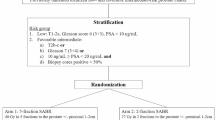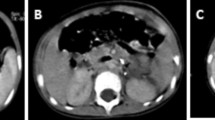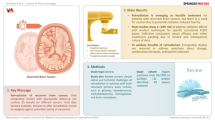Abstract
Purpose
Although microsurgery remains the first-line treatment, gross total resection of cystic craniopharyngeomas (CP) is associated with significant morbidity and mortality and the addition of external irradiation to subtotal resection proves to achieve similar tumor control. However, concern regarding long-term morbidity associated with external irradiation in children still remains. With this retrospective analysis, the authors emphasize intracavitary brachytherapy using phosphorus-32 (P-32) as a treatment option for children with cystic CP.
Patients and methods
Between 1992 and 2009, 17 children (median age 15.4 years; range 7–18 years) with cystic CP underwent intracavitary brachytherapy using P-32. Eleven patients were treated for recurrent tumor cysts; 6 patients were treated primarily. MR imaging revealed solitary cysts in 7 patients; 10 patients had mixed solid–cystic lesions (median tumor volume 11.1 ml; range 0.5–78.9 ml). The median follow-up time was 61.9 months (range 16.9–196.6 months).
Results
Local cyst control could be achieved in 14 patients (82 %). Three patients showed progression of the treated cystic formation (in-field progression) after a median time of 8.3 months (range 5.3–10.3 months), which led to subsequent interventions. The development of new, defined cysts and progression of solid tumor parts (out-of-field progression) occurred in 5 patients and led to additional interventions in 4 cases. There was neither surgery-related permanent morbidity nor mortality in this study. The overall progression-free survival was 75, 63, and 52 % after 1, 3, and 5 years, respectively.
Conclusion
Intracavitary brachytherapy using P-32 represents a safe and effective treatment option for children harboring cystic CP, even as primary treatment. However, P-32 does not clearly affect growth of solid tumor parts or the development of new cystic formations.
Zusammenfassung
Zielsetzung
Obwohl die Mikrochirurgie die Methode der Wahl darstellt, ist die komplette Resektion zystischer Kraniopharyngeome häufig mit einer signifikanten Morbidität und Mortalität assoziiert. Darüber hinaus zeigte eine additive externe Bestrahlung zur subtotalen Resektion ähnliche Ergebnisse. Es bestehen jedoch weiterhin Bedenken bezüglich der Langzeitmorbidität nach externer Bestrahlung bei Kindern. Mit dieser retrospektiven Studie wollen die Autoren die intrakavitäre Brachytherapie mit radioaktivem Phosphor-32 (P-32) als eine Behandlungsoption bei Kindern mit zystischen Kraniopharyngeomen hervorheben.
Patienten und Methoden
Zwischen 1992 und 2009 wurden 17 Kinder (medianes Alter 15,4 Jahre; Spanne 7–18 Jahre) mit zystischen Kraniopharyngeomen durch eine intrakavitäre Brachytherapie mit P-32 behandelt. Insgesamt 11 Patienten wurden aufgrund rezidivierender Tumorzysten, 6 Patienten primär behandelt. MRT-Aufnahmen zeigten solitäre Zysten bei 7 Patienten, während 10 Patienten gemischt solide-zystische Läsionen aufwiesen (medianes Tumorvolumen 11,1 ml; Spanne 0,5–78,9 ml). Die mediane Nachbeobachtungszeit betrug 61,9 Monate (Spanne 16,9–196,6 Monate).
Ergebnisse
Eine lokale Kontrolle der Tumorzyste konnte bei 14 Patienten erreicht werden (82 %). Bei 3 Patienten zeigte sich ein Progress der behandelten Zysten („in-field progression“) nach einer medianen Nachbeobachtungszeit von 8,3 Monaten (Spanne 5,3–10,3 Monaten), was nachfolgende Interventionen notwendig machte. Die Entwicklung neuer Zysten sowie die Progression solider Tumoranteile („out-of-field progression“) konnten bei 5 Patienten nachgewiesen werden. Dies führte zu weiteren Behandlungen in 4 Fällen. Es bestand weder eine operationsbedingte permanente Morbidität noch Mortalität. Das progressionsfreie Überleben betrug 75, 63 und 52 % nach 1, 3 und 5 Jahren.
Schlussfolgerung
Die intrakavitäre Brachytherapie mit P-32 stellt eine sichere und effektive Behandlungsoption für Kinder mit zystischen Kraniopharyngeomen, sogar als Primärtherapie, dar. Jedoch zeigt sich kein eindeutiger Effekt auf solide Tumoranteile, sowie auf die Entwicklung neuer Tumorzysten.


Similar content being viewed by others
References
Pettorini BL, Frassanito P, Caldarelli M, Tamburrini G, Massimi L, Di Rocco C (2010) Molecular pathogenesis of craniopharyngioma: switching from a surgical approach to a biological one. Neurosurg focus 28(4):E1. doi:10.3171/2010.1.FOCUS09300
Prabhu VC, Brown HG (2005) The pathogenesis of craniopharyngiomas. Child’s Nerv Syst 21(8–9):622–627. doi:10.1007/s00381-005-1190-9
Bunin GR, Surawicz TS, Witman PA, Preston-Martin S, Davis F, Bruner JM (1997) The descriptive epidemiology of craniopharyngioma. Neurosurg Focus 3(6):e1. doi:030601 ([pii])
Rickert CH, Paulus W (2001) Epidemiology of central nervous system tumors in childhood and adolescence based on the new WHO classification. Child’s Nerv Syst 17(9):503–511. doi:10.1007/s003810100496
Albright AL, Hadjipanayis CG, Lunsford LD, Kondziolka D, Pollack IF, Adelson PD (2005) Individualized treatment of pediatric craniopharyngiomas. Childs Nerv Syst 21(8–9):649–654. doi:10.1007/s00381-005-1185-6
Hasegawa T, Kondziolka D, Hadjipanayis CG, Lunsford LD (2004) Management of cystic craniopharyngiomas with phosphorus-32 intracavitary irradiation. Neurosurgery 54(4):813–820. (discussion 820–812)
Voges J, Sturm V, Lehrke R, Treuer H, Gauss C, Berthold F (1997) Cystic craniopharyngioma: long-term results after intracavitary irradiation with stereotactically applied colloidal beta-emitting radioactive sources. Neurosurgery 40(2):263–269. (discussion 269–270)
Halac I, Zimmerman D (2005) Endocrine manifestations of craniopharyngioma. Childs Nerv Syst 21(8–9):640–648. doi:10.1007/s00381-005-1246-x
Elliott RE, Sands SA, Strom RG, Wisoff JH (2010) Craniopharyngioma Clinical Status Scale: a standardized metric of preoperative function and posttreatment outcome. Neurosurg Focus 28(4):E2. doi:10.3171/2010.2.FOCUS09304
Caceres A (2005) Intracavitary therapeutic options in the management of cystic craniopharyngioma. Childs Nerv Syst 21(8–9):705–718. doi:10.1007/s00381-005-1227-0
Rojas EL, Al-Dweri FM, Lallena AM, Bodineau C, Galan P (2003) Dosimetry for radiocolloid therapy of cystic craniopharyngiomas. Med Phys 30(9):2482–2492
Strauss L, Sturm V, Georgi P, Schlegel W, Ostertag H, Clorius JH, van Kaick G (1982) Radioisotope therapy of cystic craniopharyngomas. Int J Radiat Oncol Biol Phys 8(9):1581–1585
Sturm V, Pastyr O, Schlegel W, Scharfenberg H, Zabel HJ, Netzeband G, Schabbert S, Berberich W (1983) Stereotactic computer tomography with a modified Riechert-Mundinger device as the basis for integrated stereotactic neuroradiological investigations. Acta Neurochir (Wien) 68(1–2):11–17
Sadeghi M, Karimi E, Sardari D (2009) Monte Carlo and analytical calculations of dose distributions in craniopharyngioma cysts treated with radiocolloids containing 32P or 186Re. Appl Radiat Isot 67(9):1697–1701. doi:S0969-8043(09)00226-7. ([pii] 10.1016/j.apradiso.2009.03.001)
Loevinger R (1954) The dosimetry of beta radiations. Radiology 62(1):74–82
Ende G, Treuer H, Boesecke R (1992) Optimization and evaluation of landmark-based image correlation. Phys Med Biol 37(1):261–271
Treuer H, Klein D, Maarouf M, Lehrke R, Voges J, Sturm V (2005) Accuracy and conformity of stereotactically guided interstitial brain tumour therapy using I-125 seeds. Radiother Oncol 77(2):202–209. doi:10.1016/j.radonc.2005.08.006
Barriger RB, Chang A, Lo SS, Timmerman RD, DesRosiers C, Boaz JC, Fakiris AJ (2011) Phosphorus-32 therapy for cystic craniopharyngiomas. Radiother Oncol 98(2):207–212. doi:S0167-8140(10)00721-8. ([pii] 10.1016/j.radonc.2010.12.001)
Marchal JC, Klein O, Thouvenot P, Bernier V, Moret C, Chastagner P (2005) Individualized treatment of craniopharyngioma in children: ways and means. Childs Nerv Syst 21(8–9):655–659. doi:10.1007/s00381-005-1211-8
Thompson D, Phipps K, Hayward R (2005) Craniopharyngioma in childhood: our evidence-based approach to management. Childs Nerv Syst 21(8–9):660–668. doi:10.1007/s00381-005-1210-9
Yang I, Sughrue ME, Rutkowski MJ, Kaur R, Ivan ME, Aranda D, Barani IJ, Parsa AT (2010) Craniopharyngioma: a comparison of tumor control with various treatment strategies. Neurosurg Focus 28(4):E5. doi:10.3171/2010.1.FOCUS09307
Elliott RE, Wisoff JH (2009) Successful surgical treatment of craniopharyngioma in very young children. J Neurosurg Pediatr 3(5):397–406. doi:10.3171/2009.1.PEDS08401. ([pii] 10.3171/2009.1.PEDS08401)
De Vile CJ, Grant DB, Kendall BE, Neville BG, Stanhope R, Watkins KE, Hayward RD (1996) Management of childhood craniopharyngioma: can the morbidity of radical surgery be predicted? J Neurosurg 85(1):73–81. doi:10.3171/jns.1996.85.1.0073
Elliott RE, Hsieh K, Hochm T, Belitskaya-Levy I, Wisoff J, Wisoff JH (2010) Efficacy and safety of radical resection of primary and recurrent craniopharyngiomas in 86 children. J Neurosurg Pediatr 5(1):30–48. doi:10.3171/2009.7.PEDS09215
Campbell PG, McGettigan B, Luginbuhl A, Yadla S, Rosen M, Evans JJ (2010) Endocrinological and ophthalmological consequences of an initial endonasal endoscopic approach for resection of craniopharyngiomas. Neurosurg Focus 28(4):E8. doi:10.3171/2010.1.FOCUS09292
Shi XE, Wu B, Zhou ZQ, Fan T, Zhang YL (2006) Microsurgical treatment of craniopharyngiomas: report of 284 patients. Chin Med J (Engl) 119(19):1653–1663
Muller HL (2011) Consequences of craniopharyngioma surgery in children. J Clinical Endocrinol Metab 96(7):1981–1991. doi:10.1210/jc.2011-0174
Muller HL (2013) Childhood craniopharyngioma. Pituitary 16(1):56–67. doi:10.1007/s11102-012-0401-0
Van Effenterre R, Boch AL (2002) Craniopharyngioma in adults and children: a study of 122 surgical cases. J Neurosurg 97(1):3–11. doi:10.3171/jns.2002.97.1.0003
Becker G, Kortmann RD, Skalej M, Bamberg M (1999) The role of radiotherapy in the treatment of craniopharyngioma–indications, results, side effects. Front Radiat Ther Oncol 33:100–113
Kiehna EN, Merchant TE (2010) Radiation therapy for pediatric craniopharyngioma. Neurosurg Focus 28(4):E10. doi:10.3171/2010.1.FOCUS09297
Rajan B, Ashley S, Thomas DG, Marsh H, Britton J, Brada M (1997) Craniopharyngioma: improving outcome by early recognition and treatment of acute complications. Int J Radiat Oncol Biol Phys 37(3):517–521. doi:S0360301696005378. ([pii])
Merchant TE, Kiehna EN, Sanford RA, Mulhern RK, Thompson SJ, Wilson MW, Lustig RH, Kun LE (2002) Craniopharyngioma: the St. Jude Children’s Research Hospital experience 1984–2001. Int J Radiat Oncol Biol Phys 53(3):533–542. doi:S0360301602027992. ([pii])
Jalali R, Mallick I, Dutta D, Goswami S, Gupta T, Munshi A, Deshpande D, Sarin R (2010) Factors influencing neurocognitive outcomes in young patients with benign and low-grade brain tumors treated with stereotactic conformal radiotherapy. Int J Radiat Oncol Biol Phys 77(4):974–979. doi:S0360-3016(09)00934-1. ([pii] 10.1016/j.ijrobp.2009.06.025)
Kalapurakal JA (2005) Radiation therapy in the management of pediatric craniopharyngiomas–a review. Childs Nerv Syst 21(8–9):808–816. doi:10.1007/s00381-005-1188-3
Keene DL, Johnston DL, Grimard L, Michaud J, Vassilyadi M, Ventureyra E (2006) Vascular complications of cranial radiation. Childs Nerv Syst 22(6):547–555. doi:10.1007/s00381-006-0097-4
Merchant TE, Kiehna EN, Kun LE, Mulhern RK, Li C, Xiong X, Boop FA, Sanford RA (2006) Phase II trial of conformal radiation therapy for pediatric patients with craniopharyngioma and correlation of surgical factors and radiation dosimetry with change in cognitive function. J Neurosurg 104(2 Suppl):94–102. doi:10.3171/ped.2006.104.2.5
Habrand JL, Saran F, Alapetite C, Noel G, El Boustany R, Grill J (2006) Radiation therapy in the management of craniopharyngioma: current concepts and future developments. J Pediatr Endocrinol Metab 19(Suppl 1):389–394
Kanesaka N, Mikami R, Nakayama H, Nogi S, Tajima Y, Nakajima N, Wada J, Miki T, Haraoka J, Okubo M, Sugahara S, Tokuuye K (2012) Preliminary results of fractionated stereotactic radiotherapy after cyst drainage for craniopharyngioma in adults. Int J Radiat Oncol Biol Phys 82(4):1356–1360. doi:10.1016/j.ijrobp.2011.05.014
Bartels U, Laperriere N, Bouffet E, Drake J (2012) Intracystic therapies for cystic craniopharyngioma in childhood. Front Endocrinol 3:39. doi:10.3389/fendo.2012.00039
Hechtman CD, Li Z, Mansur DB, Perez CA, Myerson RJ, Simpson JR, Anders JC, Wu C, Palucci CA (2005) Dose distribution outside of a sphere of P-32 chromic phosphorous colloid. Int J Radiat Oncol Biol Phys 63(3):961–968. doi:S0360-3016(05)00018-0. ([pii] 10.1016/j.ijrobp.2004.12.071)
Zhao R, Deng J, Liang X, Zeng J, Chen X, Wang J (2010) Treatment of cystic craniopharyngioma with phosphorus-32 intracavitary irradiation. Childs Nerv Syst 26(5):669–674. doi:10.1007/s00381-009-1025-1
Julow J, Backlund EO, Lanyi F, Hajda M, Balint K, Nyary I, Szeifert GT (2007) Long-term results and late complications after intracavitary yttrium-90 colloid irradiation of recurrent cystic craniopharyngiomas. Neurosurgery 61(2):288–295. doi:10.1227/01.NEU.0000255528.68963.EF. (discussion 295–286)
Acknowledgments
The authors FE, VS, and MM were at the Department of Stereotaxy and Functional Neurosurgery, University Hospital of Cologne during conceptualization, collection, and evaluation of the study data and moved to different institutions thereafter.
Author information
Authors and Affiliations
Corresponding authors
Ethics declarations
Conflict of interest
M. Maarouf, F. El Majdoub, M. Fuetsch, M. Hoevels, R. Lehrke, F. Berthold, J. Voges, and V. Sturm state that there are no conflicts of interest.
The accompanying manuscript does not include studies on humans or animals.
Rights and permissions
About this article
Cite this article
Maarouf, M., Majdoub, F., Fuetsch, M. et al. Stereotactic intracavitary brachytherapy with P-32 for cystic craniopharyngiomas in children. Strahlenther Onkol 192, 157–165 (2016). https://doi.org/10.1007/s00066-015-0910-7
Received:
Accepted:
Published:
Issue Date:
DOI: https://doi.org/10.1007/s00066-015-0910-7




